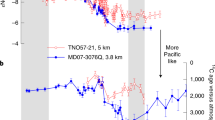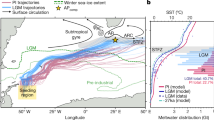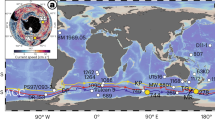Abstract
Glacial terminations during the late Pleistocene epoch are associated with changes in insolation. They are also punctuated by millennial-scale climate shifts, characterized by a weakening and subsequent strengthening of the Atlantic meridional overturning circulation. This ubiquitous association suggests that these oscillations may be a necessary component of deglaciation. Model simulations have suggested that the period of weakened circulation during these terminal oscillations would be followed by an overshoot of the circulation on its resumption, but this phenomenon has not yet been observed. Here we use radiocarbon measurements of benthic foraminifera and carbonate preservation indices to reconstruct ventilation changes in the deep South Atlantic Ocean over the past 40,000 years. We find evidence for a particularly deep expansion of the Atlantic overturning cell directly following the weak mode associated with Heinrich Stadial 1. Our analysis of an ocean general circulation model simulation suggests that North Atlantic Deep Water export during the expansion was greater than that of interglacial conditions. We find a similar deep expansion during Dansgaard–Oeschger Interstadial Event 8, 38,000 years ago, which followed Heinrich Stadial 4. We conclude that the rise in atmospheric CO2 concentrations and resultant warming associated with an especially weak overturning circulation are sufficient to trigger a switch to a vigorous circulation, but a full transition to interglacial conditions requires additional forcing at an orbital scale.
This is a preview of subscription content, access via your institution
Access options
Subscribe to this journal
Receive 12 print issues and online access
$259.00 per year
only $21.58 per issue
Buy this article
- Purchase on Springer Link
- Instant access to full article PDF
Prices may be subject to local taxes which are calculated during checkout




Similar content being viewed by others
References
Ganachaud, A. & Wunsch, C. Improved estimates of global ocean circulation, heat transport and mixing from hydrographic data. Nature 408, 453–457 (2000).
Curry, W. B. & Oppo, D. W. Glacial water mass geometry and the distribution of δ13C of ΣCO2 in the western Atlantic Ocean. Paleoceanography 20, PA1017 (2005).
Weber, S. L. et al. The modern and glacial overturning circulation in the Atlantic Ocean in PMIP coupled model simulations. Clim. Past 3, 51–64 (2007).
Hays, J. D., Imbrie, J. & Shackleton, N. J. Variations in the Earth’s orbit: Pacemaker of the Ice Ages. Science 194, 1121–1132 (1976).
Raymo, M. E. The timing of major climate terminations. Paleoceanography 12, 577–585 (1997).
Huybers, P. & Wunsch, C. Obliquity pacing of the late Pleistocene glacial terminations. Nature 434, 491–494 (2005).
Clark, P. U. et al. The last glacial maximum. Science 325, 710–714 (2009).
McManus, J. F., Francois, R., Gherardi, J. M., Keigwin, L. D. & Brown-Leger, S. Collapse and rapid resumption of Atlantic meridional circulation linked to deglacial climate changes. Nature 428, 834–837 (2004).
Barker, S. et al. Interhemispheric Atlantic seesaw response during the last deglaciation. Nature 457, 1097–1102 (2009).
Knorr, G. & Lohmann, G. Southern Ocean origin for the resumption of Atlantic thermohaline circulation during deglaciation. Nature 424, 532–536 (2003).
Cheng, H. et al. Ice age terminations. Science 326, 248–252 (2009).
Severinghaus, J. P. & Brook, E. J. Abrupt climate change at the end of the last glacial period inferred from trapped air in polar ice. Science 286, 930–934 (1999).
Knorr, G. & Lohmann, G. Rapid transitions in the Atlantic thermohaline circulation triggered by global warming and meltwater during the last deglaciation. Geochem. Geophys. Geosyst. 8, Q12006 (2007).
Liu, Z. et al. Transient simulation of last deglaciation with a new mechanism for Bølling–Allerød warming. Science 325, 310–314 (2009).
Gherardi, J. M. et al. Glacial–interglacial circulation changes inferred from Pa-231/Th-230 sedimentary record in the North Atlantic region. Paleoceanography 24, PA2204 (2009).
Ninnemann, U. S. & Charles, C. D. Changes in the mode of Southern Ocean circulation over the last glacial cycle revealed by foraminiferal stable isotopic variability. Earth Planet. Sci. Lett. 201, 383–396 (2002).
Piotrowski, A. M., Goldstein, S. L., Hemming, S. R. & Fairbanks, R. G. Temporal relationships of carbon cycling and ocean circulation at glacial boundaries. Science 307, 1933–1938 (2005).
Vidal, L. et al. Evidence for changes in the North Atlantic deep water linked to meltwater surges during the Heinrich events. Earth Planet. Sci. Lett. 146, 13–27 (1997).
Robinson, L. F. et al. Radiocarbon variability in the western North Atlantic during the last deglaciation. Science 310, 1469–1473 (2005).
Skinner, L. C. & Shackleton, N. J. Rapid transient changes in northeast Atlantic deep water ventilation age across Termination I. Paleoceanography 19, PA2005 (2004).
Anderson, R. F. et al. Wind-driven upwelling in the southern ocean and the deglacial rise in atmospheric CO2 . Science 323, 1443–1448 (2009).
Marchitto, T. M., Lehman, S. J., Ortiz, J. D., Fluckiger, J. & van Geen, A. Marine radiocarbon evidence for the mechanism of deglacial atmospheric CO2 rise. Science 316, 1456–1459 (2007).
Broecker, W. S. & Barker, S. A 190‰ drop in atmospheric Δ14C during the ‘mystery interval’ (17.5 to 14.5 kyrs). Earth Planet. Sci. Lett. 256, 90–99 (2007).
Maier-Reimer, E., Mikolajewicz, U. & Hasselmann, K. Mean circulation of the Hamburg LSG OGCM and its sensitivity to the thermohaline surface forcing. J. Phys. Oceanogr. 23, 731–757 (1993).
Ganopolski, A. & Rahmstorf, S. Rapid changes of glacial climate simulated in a coupled climate model. Nature 409, 153–158 (2001).
Ganopolski, A. & Roche, D. M. On the nature of lead-lag relationships during glacial–interglacial climate transitions. Quat. Sci. Rev. 28, 3361–3378 (2009).
Thornalley, D. J. R., McCave, I. N. & Elderfield, H. Freshwater input and abrupt deglacial climate change in the North Atlantic. Paleoceanography 25, PA1201 (2010).
Skinner, L. C., Fallon, S., Waelbroeck, C., Michel, E. & Barker, S. Ventilation of the deep Southern Ocean and deglacial CO2 rise. Science 328, 1147–1151 (2010).
Wang, X. F. et al. Wet periods in northeastern Brazil over the past 210 kyr linked to distant climate anomalies. Nature 432, 740–743 (2004).
Curry, W. B., Marchitto, T. M., McManus, J. F., Oppo, D. W. & Laarkamp, K. L. in Mechanisms of Global Climate Change at Millennial Time Scales (eds Clark, P. U., Webb, R. S. & Keigwin, L. D.) (Am. Geophys. Union, 1999).
Adkins, J. F., McIntyre, K. & Schrag, D. P. The salinity, temperature, and δ18O of the glacial deep ocean. Science 298, 1769–1773 (2002).
NGRIP members, High-resolution record of Northern Hemisphere climate extending into the last interglacial period. Nature 431, 147–151 (2004).
Key, R. M. et al. A global ocean carbon climatology: Results from Global Data Analysis Project (GLODAP). Glob. Biogeochem. Cycles 18, GB4031 (2004).
EPICA, One-to-one coupling of glacial climate variability in Greenland and Antarctica. Nature 444, 195–198 (2006).
Berger, A. & Loutre, M. F. Insolation values for the climate of the last 10 million years. Quat. Sci. Rev. 10, 297–317 (1991).
Acknowledgements
We thank T. Van de Flierdt, D. Thornalley, P. Sexton and W. Broecker for useful discussions and H. Medley for help in the laboratory. Sample material used in this project was provided by the Lamont-Doherty Earth Observatory Deep-Sea Sample Repository. We thank R. Lotty and G. Lozefski for their help with sampling. Support for the collection and curating facilities of the core collection is provided by the National Science Foundation through Grant OCE00-02380 and the Office of Naval Research through Grant N00014-02-1-0073. The work was supported by a National Science Foundation (US) grant (OCE -0435703) and Natural Environment Research Council (UK) grants NE/F002734/1 and NE/G004021/1.
Author information
Authors and Affiliations
Contributions
S.B. designed and managed the project, G.K. carried out model analysis, S.B. and G.K. developed interpretation with help from all authors. M.J.V. carried out foraminiferal counts, P.D. picked and prepared benthic foraminifera for 14C dating. All authors contributed to writing the manuscript.
Corresponding authors
Ethics declarations
Competing interests
The authors declare no competing financial interests.
Supplementary information
Supplementary Information
Supplementary Information (PDF 765 kb)
Rights and permissions
About this article
Cite this article
Barker, S., Knorr, G., Vautravers, M. et al. Extreme deepening of the Atlantic overturning circulation during deglaciation. Nature Geosci 3, 567–571 (2010). https://doi.org/10.1038/ngeo921
Received:
Accepted:
Published:
Issue Date:
DOI: https://doi.org/10.1038/ngeo921
This article is cited by
-
Millennial and centennial CO2 release from the Southern Ocean during the last deglaciation
Nature Geoscience (2022)
-
Asian monsoon intensity coupled to Antarctic climate during Dansgaard–Oeschger 8 and Heinrich 4 glacial intervals
Communications Earth & Environment (2022)
-
Radiocarbon dating
Nature Reviews Methods Primers (2021)
-
Glacial heterogeneity in Southern Ocean carbon storage abated by fast South Indian deglacial carbon release
Nature Communications (2020)
-
The nature of deep overturning and reconfigurations of the silicon cycle across the last deglaciation
Nature Communications (2020)



